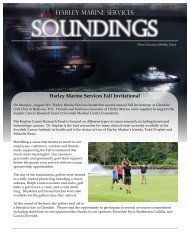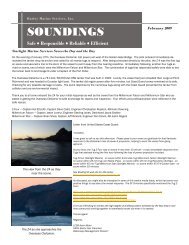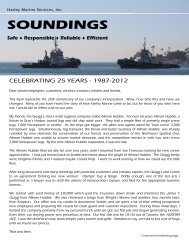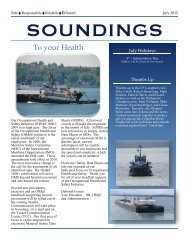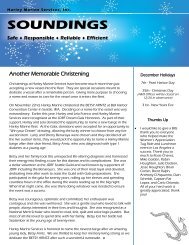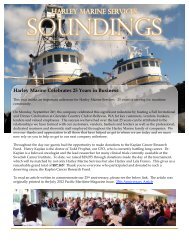March - Harley Marine Services, Inc.
March - Harley Marine Services, Inc.
March - Harley Marine Services, Inc.
You also want an ePaper? Increase the reach of your titles
YUMPU automatically turns print PDFs into web optimized ePapers that Google loves.
SO UN DI NG S Page 9<br />
National Safety Council Calls for Nationwide Ban on<br />
Cell Phone Use While Driving<br />
Driver inattention is a leading cause of traffic crashes, responsible for about 80 percent of all<br />
collisions, according to the National Highway Traffic Safety Administration (NHTSA). Considering<br />
crashes are the number-one cause of accidental death in the U.S., it is important to pay close<br />
attention to our driving habits and those of other drivers.<br />
Talking on a cell phone and sending text messages are much higher risk activities that occur for<br />
longer durations and with more people than most other actions engaged in while driving.<br />
In a sweeping effort to eliminate the dangerous practice of using cell phones and messaging devices<br />
while behind the wheel, the National Safety Council (NSC) has asked motorists to stop calling or<br />
texting while driving, urged governors and legislators in all 50 states and the District of Columbia to<br />
pass laws banning this behavior, and encouraged businesses to enact policies against it.<br />
“Studies show that driving while talking on a cell phone is extremely dangerous and puts drivers at a<br />
four times greater risk of a crash,” said Janet Froetscher, president and CEO of NSC. “Driving drunk<br />
is also dangerous and against the law. When our friends have been drinking, we take the car keys<br />
away. It’s time to take the cell phone away.”<br />
A study from the Harvard Center of Risk Analysis estimates that cell phone use while driving<br />
contributes to 6 percent of crashes, which equates to 636,000 crashes, 330,000 injuries, 12,000<br />
serious injuries and 2,600 deaths each year. The study also put the annual financial toll of cell phonerelated<br />
crashes at $43 billion.<br />
“When you’re on a call, even if both hands are on the wheel, your head is in the call, and not on your<br />
driving,” Froetscher said. “Unlike the passenger sitting next to you, the person on the other end of the<br />
call is oblivious to your driving conditions. The passenger provides another pair of eyes on the road.”<br />
A significant amount of vehicular cell phone use is done on the job. Many businesses have already<br />
acknowledged the injuries and costs associated with this behavior by adopting policies that ban cell<br />
phone use by employees on the roads. Among NSC member businesses that responded to a survey,<br />
45 percent said they have company policies prohibiting on-road cell phone use. Of those, 85 percent<br />
said the policies make no difference in business productivity.<br />
“Anyone with a busy job knows the temptation to multi-task and stay in touch with the office while<br />
driving,” Froetscher said. “Believe me, I’ve been there. I didn’t realize how much risk I was taking.<br />
Most people don’t. Employers understand how dangerous the behavior is and their potential liability.<br />
We are asking all businesses to join us by adopting policies banning calling and texting while driving<br />
on the job.”<br />
While in some States it is still not illegal, CA, NY, OR, and WA states all have laws prohibiting the use<br />
of cell phones while driving without the use of a hands free device. Please remember that HMS<br />
company policy states that employees should not use cell phones while driving without the use of a<br />
hands free device.<br />
Andre Nault<br />
Safety Manager, California





